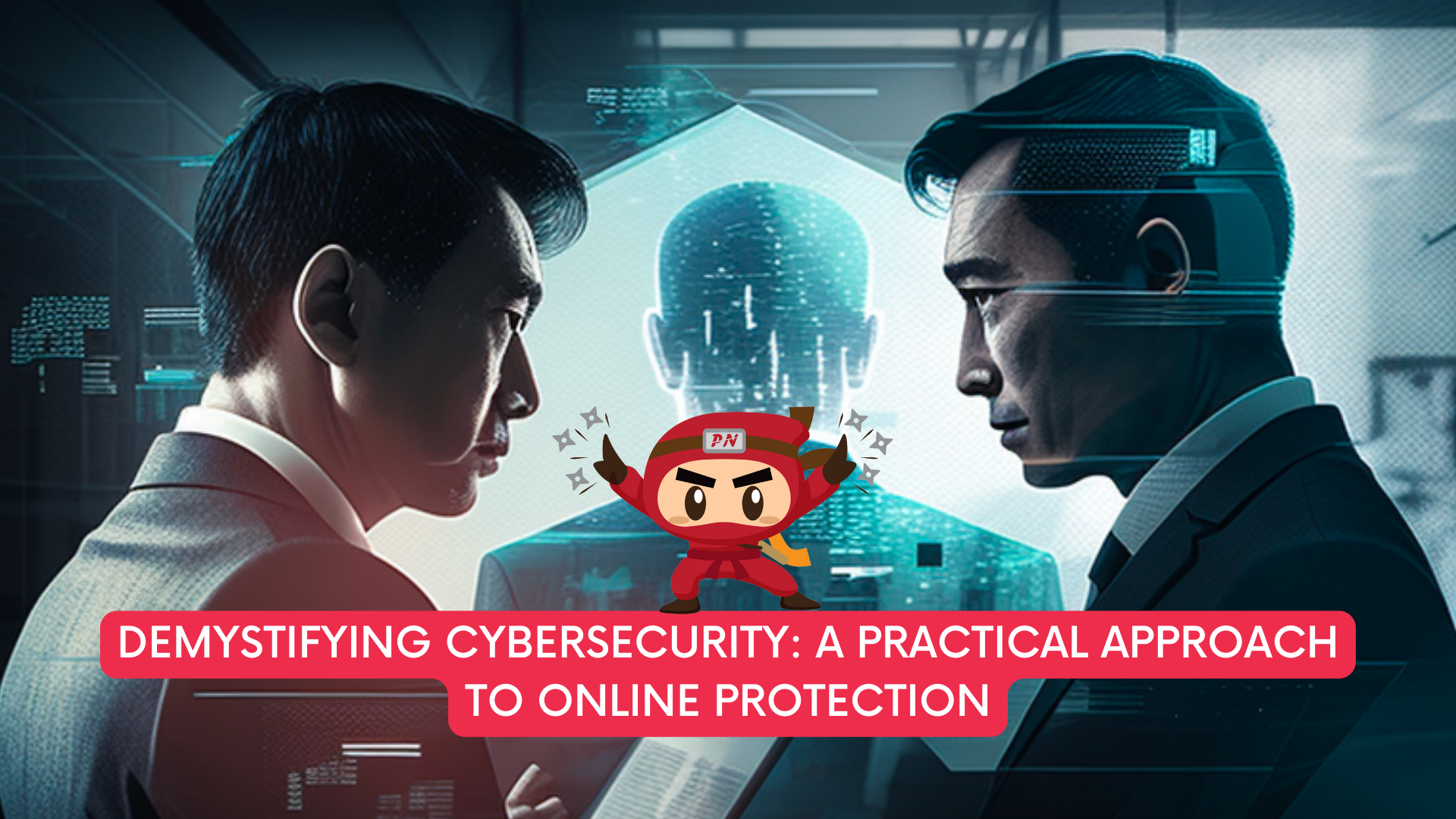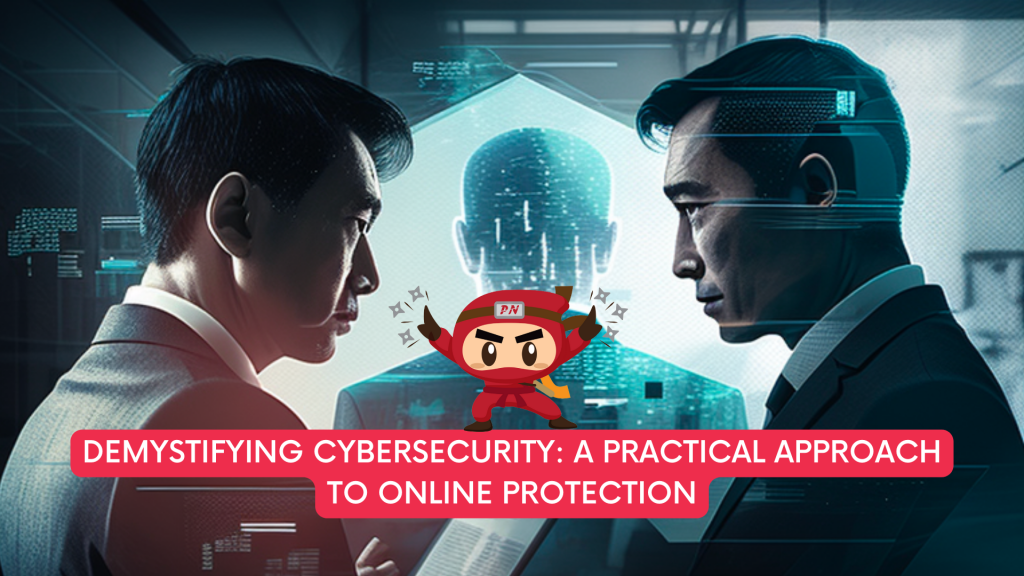KEEP IN TOUCH
Subscribe to our mailing list to get free tips on Data Protection and Cybersecurity updates weekly!







The importance of cybersecurity cannot be overstated. As we navigate the vast landscape of the internet, our digital footprints leave trails of personal information. With cyber threats becoming increasingly sophisticated, it’s imperative to demystify cybersecurity and adopt a practical approach to online protection.
This article delves into key concepts, strategies, and best practices to empower individuals and organizations in safeguarding their digital presence.
Cybersecurity is often viewed as a complex and elusive realm, filled with jargon and technical intricacies. At its core, however, cybersecurity is about protecting digital assets, data, and identities from unauthorized access, attacks, and potential harm. Demystifying cybersecurity begins with understanding its fundamental principles and adopting a mindset that prioritizes proactive defense.
The first step in any cybersecurity strategy is self-awareness. Individuals and organizations alike should assess their digital footprint – the collective trail of online activities, accounts, and information. Conduct a comprehensive audit of the devices you use, the accounts you maintain, and the data you share. This awareness forms the foundation for developing targeted security measures.

A practical and effective entry point into cybersecurity is the adoption of strong password practices. Passwords act as the initial defense against unauthorized access. Create complex, unique passwords for each account, incorporating a mix of uppercase and lowercase letters, numbers, and symbols. Regularly update passwords and consider leveraging password manager tools for enhanced convenience and security.
Two-Factor Authentication (2FA) adds an extra layer of security beyond passwords. By requiring a secondary form of verification, such as a code sent to your mobile device, 2FA significantly reduces the risk of unauthorized access. Embrace 2FA wherever available to fortify your accounts against potential breaches.
Phishing remains a prevalent and effective cyber attack method. Arm yourself with knowledge on how to identify phishing attempts, which often involve deceptive emails, messages, or websites aiming to trick individuals into divulging sensitive information. Exercise caution when clicking links, verify sender authenticity, and be skeptical of unsolicited requests for personal information.
Cybercriminals frequently exploit vulnerabilities in outdated software and systems. A practical cybersecurity approach involves regular updates and patches. Enable automatic updates for your operating systems, antivirus software, and applications. Timely updates close security gaps and enhance the overall resilience of your digital environment.
Data loss can occur due to various reasons, including cyber attacks, hardware failures, or accidental deletions. A practical cybersecurity measure involves implementing a robust backup strategy. Regularly back up essential data to external drives or secure cloud services to ensure swift recovery in case of an unforeseen event.

As remote work and smart home devices become commonplace, securing your home network is paramount. Change default router passwords, enable encryption, and regularly update router firmware. Create a separate network for IoT devices to mitigate the risk of unauthorized access to sensitive data.
Virtual Private Networks (VPNs) enhance online privacy and security by encrypting internet connections. Consider using a reputable VPN, especially when connecting to public Wi-Fi networks. VPNs provide an additional layer of protection, shielding your online activities from potential eavesdroppers.
The cybersecurity landscape is dynamic, with new threats emerging regularly. Adopt a proactive approach by staying informed about the latest cyber threats, attack methods, and security vulnerabilities. Follow reputable cybersecurity blogs, subscribe to threat intelligence feeds, and participate in relevant forums to stay ahead of potential risks.
Demystifying cybersecurity is not only about individual actions but also about fostering a culture of cybersecurity within organizations and communities. Promote awareness, conduct regular training sessions, and emphasize the shared responsibility of everyone in maintaining a secure digital environment.
Cybersecurity is a collective effort. Individuals, businesses, and governments must collaborate to enhance cyber resilience. Share best practices, report suspicious activities, and contribute to a culture of openness and cooperation in addressing cyber threats.
In conclusion, demystifying cybersecurity is about embracing a practical and proactive approach to online protection. By understanding the fundamentals, adopting strong password practices, leveraging 2FA, staying informed, and fostering a culture of cybersecurity, individuals and organizations can empower their digital defense. In an interconnected world, where the digital landscape is both vast and dynamic, a commitment to cybersecurity is not just a necessity but a fundamental step towards a safer and more resilient digital future.
Your appointed DPO can work with you on your PDPA compliance, ensuring that there will be policies in place to make sure that the handling of personal data is PDPA compliant.
A Data Protection Officer (DPO) oversees data protection responsibilities and ensures that organisations comply with the Personal Data Protection Act (PDPA). Furthermore, every Organisation’s DPO should be able to curb any instances of PDPA noncompliance as it is the officer responsible for maintaining the positive posture of an organisation’s cybersecurity.
DPOs complement organisations’ efforts to ensure that the organisation’s methods of collecting personal data comply with the PDPA. It also ensures that policies are set in place to make sure that there will be no instances of data breaches in the future.
Don’t wait any longer to ensure your organisation is PDPA compliant. Take our free 3-minute PDPA Compliance Self-audit checklist now, the same “secret weapon” used by our clients to keep them on track. Upon completion, we will send you the results so you can take the necessary action to protect your customers’ data. Complete the free assessment checklist today and take the first step towards protecting your customers’ personal data.